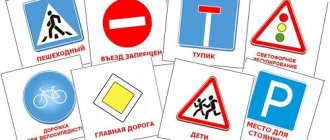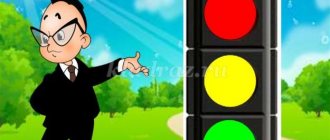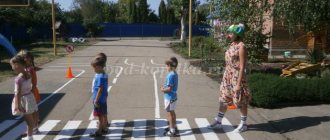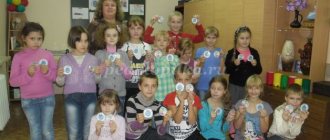Conversation on traffic rules in a preschool educational institution. Senior group
Topic: “Public transport” for children of senior preschool age. Purpose: this material will help organize a conversation on traffic rules with preschoolers, and will also be useful to educators and parents. Prepared by: Chekhovskaya Elena Rashidovna, teacher of the first qualification category, MBDOU No. 28, Shakhty, Rostov region.
Goal: To introduce the rules of a road user, broaden one’s horizons, give an idea of the dangers on the road - to teach a child to live and act in real life, to become familiar with the rules of behavior in public transport and outside it. Objectives: - to give an idea of the distinctive features of public transport, - to expand knowledge about the rules of behavior on the road, - to teach how to be educated passengers in public transport, - to cultivate responsibility for one’s life. Progress of the conversation. -We begin our journey to the country of road literacy. — What is traffic rules? (Road rules.) - Why is it necessary to know the rules? — How do you understand the words “dangerous situation on the road”? -What could be the cause of “dangerous situations on the road”? — Traffic rules are a road map. Everyone should own one to prevent accidents. Game "Answer quickly and correctly."
The inspector-teacher asks the children various questions related to road safety. (The game can be repeated several times.) 1. What parts does the street consist of?
(Sidewalks, roadways, intersections) 2. Where can people walk? (On the sidewalk) 3. Where can you cross the street? (At pedestrian crossings) 4.What pedestrian crossings do you know? (ground, underground, overground) 5. When you cross the road at a zebra crossing, where should you look first? (To the left, and in the middle - to the right.) 6. What does a pedestrian crossing indicate? (Traffic light, zebra crossing, road sign.) 7. At what traffic light can you cross the road? (On green.) Awarding the best children with prizes. Problem message. Today we will talk about transport on city streets. Transport exists for the rapid movement of people over short and long distances. - What is it called?
Public transport is a vehicle designed to transport a large number of passengers that runs along certain routes. As soon as we buy a ticket for any type of public transport, we are passengers.
Guess the riddles.[/
b] 1. Doesn’t fly, doesn’t buzz, The beetle is running down the street. And two brilliant lights burn in the beetle’s eyes. (Car) (M. Doroshin.)
2. The house goes down the street, taking everyone to work. Not on thin chicken legs, but in rubber boots. (Bus.) (M. Doroshin.)
-Find the similarities and differences between a car and a bus.
(big, small, many passengers. Buses and cars pollute the air with exhaust gases - this is very bad.) -Where do people use such public transport? Physical education
We rode a horse, got to the corner, got into the car, poured gasoline. We drove by car and reached the river. Trrr! Stop! U-turn. We need to get on the plane. The plane is flying, the engine is humming: -U-U-U! 3. Early in the morning outside the window - Knocking and ringing and chaos: Red houses walk along straight steel paths. (Tram.)
-Tram is an electric rail public transport. It has an arc on the roof that moves along an electrical wire located at the top. The current flows through the arc to the tram engine, and through the engine to the wheels. — What is the difference between a tram and a bus? — Where do people use such transport? 4. Amazing carriage! Judge for yourself: The rails are in the air, and he holds them with his hands! (Trolleybus.)
— How does a trolleybus differ from a tram?
What common? — Where do people use such transport? — What should a driver of any public transport be like? (attentive, experienced, knowledgeable, smart, healthy, polite.) Rules of conduct for passengers in public transport.
— Tell us about the rules of behavior at a bus stop, in transport? (Don’t linger in the aisle. Pay the fare. Don’t litter, don’t make noise, don’t distract the driver. Don’t lean out of the windows of the transport. Give up your seat to older people, passengers with children.) - How should you enter public transport? (Through the back door.) - How should you get out of the vehicle? (Through the front door.) How to get around public transport? Remember! A stationary tram is bypassed from the FRONT! Bus and trolleybus - BACK!
Role-playing game “We are passengers.”
Goal: to consolidate the rules of behavior for passengers at a bus stop, in transport, when exiting a transport. — Let's distribute the roles: driver, pedestrians, passengers, inspector. (Make transport out of chairs in advance.) - Boarding the bus. — Disembarking passengers and walking around the bus. (Trolleybus, tram.) Result of the conversation. — What happens if we violate the rule of bypassing traffic? Our journey to the land of the road map is over.
We recommend watching:
Leisure time in the senior group on traffic rules Scenario of a speech by a propaganda team on traffic rules for children of the senior group Conversation in the senior group on the topic: Traffic rules Lesson summary for children 5-7 years old “Travel according to traffic rules”
Similar articles:
Summary of a lesson on traffic rules in the senior group in kindergarten. Rules for pedestrians and passengers
Summary of a lesson on traffic rules in the senior group in kindergarten. Types of traffic signs. Warning road signs
Summary of a lesson on traffic rules in the senior group of kindergarten. Rules for cyclists
Tasks on traffic rules for preschoolers in pictures
Parent meeting on traffic rules in kindergarten
MBDOU Kindergarten No. 12, Khodz village, Koshekhablsky district, Republic of Adygea.
Goal: Intensifying the activities of children in the senior group to teach the rules of safe behavior on the roads and the prevention of children's road traffic injuries. Expanding children's knowledge about the rules of behavior on the road in winter and the ability to apply the acquired knowledge about traffic rules in games and in everyday life. Combining the efforts of educators and parents to familiarize children with the rules of the road and their observance in life. Development of visual materials that have a developmental and cognitive impact on older children. Objectives: To generalize and expand children's knowledge about traffic rules in winter. To develop the psychophysiological qualities of the child, ensuring his safety in the process of road traffic. Foster patriotic feelings for your hometown. Instill responsibility for the safety of your life and the lives of other people. Reinforce the need to comply with traffic rules.
Progress of the conversation. Pinocchio arrives. Hello guys! And today I managed to visit the school of pedestrian sciences. They told me what to do to save my life.
Rule #1. Where on the roads can you cross the road? Do you know? That's right, you need to follow the traffic rules. Let's remember them all. That's right, you can only cross the road at pedestrian crossings. They are marked with a special “pedestrian crossing” sign. Look here (shows a sign). Guys, do you know what is the safest crossing? This is underground. It is designated like this (shows a sign). Rule #2. If there is no underground crossing, you must use a crossing with a traffic light. Do you know the traffic lights? Right. "Red man" means "stop!" and "green man" means "go!" Rule No. 3. You cannot cross the road at a red light, even if there are no cars. Rule #4. When crossing the road, you should always look both ways. Where should we look first? Yes, first go left, and when you reach the middle of the road, go right. Rule #5. It is safest to cross the road with a group of pedestrians. Even stray dogs who do not know the rules of the road understand this. Under no circumstances should you run out onto the road. You have to stop before the road. Guys, why can’t you run out onto the road? Can you play on the road? Why? Right. Rule #6. You cannot play on the roadway or on the sidewalk. Guys, if your parents have forgotten which side you need to go around a bus, trolleybus and tram, you can remind them that: A bus and a trolley bus at a stop should only be bypassed from behind, and a tram can only be bypassed from the front. Agreed? Well done guys! Remember all the rules. This is cool! But now it’s time for me. I’ll go to the other guys and remind them of the rules. See you soon! “Play and be brave!” Objectives: develop mental abilities and visual perception; learn to correlate the verbal form of description of road signs with their graphic representation; cultivate independence, speed of reaction, and ingenuity. Rules: the image of a road sign is closed only after listening to information about it. The winner is the one who is the first to correctly cover all the images sounded in riddles or poems. *4-6 children participate in the game, in front of whom are laid out tables with images of road signs and blank cards. The principle of the game is lotto. The teacher reads riddles (poems) about road signs, the children cover their images on the table with cards: Hey, driver, be careful! It's impossible to go fast. People know everything in the world - Children walk in this place! (Sign “Children”) * There are road works here - No driving, no walking. It's better for pedestrians to just walk around this place. (Road Works sign) * It has two wheels and a saddle on a frame. There are two pedals at the bottom, you turn them with your feet. He stands in the red circle and talks about the ban. (Sign “No cycling”) * I’m not at all afraid of this zebra on the road If everything around is in order, I’ll set off along the stripes. (Pedestrian crossing sign) * I didn’t wash my hands on the road, I ate fruits and vegetables. I got sick and see a Medical Aid station. (Sign “First aid station”) Game “Think - Guess!” Objectives: to activate the processes of thinking, attention and speech of children; clarify your understanding of transport and traffic rules; cultivate intelligence and resourcefulness. Rules: you must give the correct answer and not shout it out in unison. The one who gets more chips for correct answers wins. Educator. I will ask you questions. Anyone who knows the correct answer should raise their hand. Whoever answers correctly first gets a chip. At the end of the game we will count the chips and reveal the winner.
Questions: - How many wheels does a car have? (4) - How many people can ride on one bike? (1) - Who walks on the sidewalk? (pedestrian) - Who is driving the car? (Driver) - What is the name of the place where two roads intersect? (Intersection) - What is the roadway for? (for traffic) - On which side of the roadway is traffic moving? (On the right) - What can happen if a pedestrian or driver violates traffic rules? (Accident or traffic accident) - What is the top light at the traffic light? (Red) - At what age are children allowed to ride a bicycle on the street? (from 14 years old) - How many signals does a pedestrian traffic light have? (Two) - How many signals does a pedestrian traffic light have? (Three) - What animal does a pedestrian crossing look like? (At the zebra crossing) - How can a pedestrian get into the underground passage? (Down the stairs) - If there is no sidewalk, where can a pedestrian move? (On the side of the road on the left, towards traffic) - Which cars are equipped with special sound and light signals? (Ambulance, fire and police cars) - What is the traffic police inspector holding in his hand? (Rod) - Where should you play so as not to be in danger? (In the yard, on the playground).
Conversation on the topic: “Road Safety”
Consultation for parents
“How to develop safe behavior skills on the street”
One of the main reasons for road accidents with children is that children in their behavior on the street are guided by observations of the actions of adults in similar situations. Unfortunately, this action is not always correct. How to teach children to behave safely on the street? Just warnings like “be careful” will not help matters significantly. Daily training of the child’s movements and attention is necessary, combined with the constant personal example of the parents. Only in this case can children develop solid skills for safe behavior on the street.
Observation skill. The child must learn to see objects that block the view of the roadway as dangerous objects or hiding danger. To do this, he needs to repeatedly show these objects from the sidewalk when they hide, are about to hide, or have just hidden a moving car. In the same way, the child must learn to see distractions as danger signals. Such a factor could be a bus stopping on the opposite side of the street. Rushing towards it, people often fall under the wheels of passing cars. The reason is that their attention at this moment is switched only to their bus.
The skill of calm, fairly confident behavior on the street is developed through the personal example of parents. This skill is very important for a child, so an adult, walking down the street with his son or daughter, should not give in to excitement or haste, no matter what circumstances force him to do so.
The skill of switching to the street. The curbstone of the sidewalk is the boundary beyond which the habits that operate in everyday life end. It is necessary to teach the child to notice this boundary: to slow down, stop, and take the necessary pause for psychological switching in connection with the transition to the danger zone. And here the example of parents is crucial.
The skill of switching to self-control. Once on the roadway, the child must monitor his behavior and correctly assess the road situation. Developing such a skill requires some training under the guidance of a teacher and parents.
How should adults behave when outdoors with a child? If you are holding a child, be careful: he is blocking your view of the street. You cannot carry a child on a sled on or near the road. Such “transport”, as is known, easily tips over. When traveling in a taxi, it is necessary that passengers with children sit in the back seat - as prescribed by the Traffic Rules. Also take into account the possibility of sudden braking and protect your child from injury. When disembarking, adults must leave first and receive children. The bus is approaching the stop. Until the bus stops moving completely, you should not approach it; a child (like an adult) can trip and get run over, especially if there are a lot of passengers at the stop. The stopping zone is a dangerous place for a child. The fact is that a standing bus reduces the view of the Road in this area, both for drivers of passing cars and for pedestrians. In addition, pedestrians here are often in a hurry and a child can be pushed onto the roadway. Even an experienced driver cannot always avoid sudden braking in an emergency situation. Therefore, when traveling on public transport, you must ensure that the child is in a stable position. You need to be especially careful near the driver’s cabin and when preparing to exit. Adults are always the first to get off the bus, trolleybus, or tram and receive the child. If you let children go ahead, they can break free from your arms and run out onto the road, and a small child, walking on steps designed for an adult, can fall. When walking down the street hand in hand with a child, do not forget that the child may try to break free. This is a common cause of childhood road injuries. Teach children to observe. It is from the age of two to seven, while he is on the street next to you, that it is best to instill in him the skills mentioned above. Use every occasion of being on the street with your child to teach him to see and guess typical road “traps”. When crossing the street, let him also observe, and not just trust you. Otherwise, the baby will get used to walking across the street without looking. Do not allow your child to run ahead of you at the end of the crossing. This reinforces the same habit of moving along the street without observing the traffic situation. If your child wears glasses, he can only see well in front of him, and on the street, so-called peripheral vision plays an important role. Since it remains weakened, special care must be taken to teach the child to correctly assess the speed of approaching traffic, to recognize typical situations of obstructed vision and distraction. When walking down the street with a child, do not rush on the roadway, run across the road to the bus, talk about strangers while crossing, move at a red traffic light or make a prohibiting gesture from a traffic controller.
Progress of the conversation:
— Guys, we recently talked about the fact that when going out, going on a visit , or on any trip, we all must follow the rules of pedestrians and drivers . Today I want to see if you remember these rules . And the traffic police inspector’s baton will help me with this!
D/game “Jolly Rod”
Purpose: to generalize ideas about the rules of behavior for pedestrians on the street ; activate children's knowledge, their speech, memory, thinking; cultivate a desire to comply with traffic rules in life.
Rules : listen carefully to the answers of your comrades and do not repeat yourself. The team that names the most rules for pedestrians . You can give an answer only after receiving the rod in your hands.




